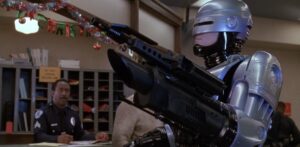My Thoughts on Star Trek: Picard’s Premiere Episode

This article contains spoilers for Star Trek: Picard’s first episode.
Star Trek: Picard is trying to maintain a delicate balance. For the first time since 2002’s Star Trek: Nemesis – and the briefest of glimpses in the 2009 reboot – Star Trek’s prime timeline is being pushed forward to where no show or film has gone before. But the vessel for finally progressing into these uncharted territories is one we know all too well. Not a brand-new character or crew but rather Jean-Luc Picard, a retired admiral now in his 90’s, bringing with him into this new trek among the stars the nostalgia of 178 episodes of Star Trek: The Next Generation and four motion pictures. While we’ve only seen one of the season’s ten episodes, it seems the much-anticipated series is doing the impossible and keeping its balance on that particular tightrope as the stormy winds of the fandom’s expectations constantly bluster.
 Balance really is the word that springs to mind after this episode. This is a Star Trek series like none before, focusing on a sole character, and while the title of ‘Star Trek: Picard’ is immensely unimaginative, it appears that it’s the perfect title. The show wisely chooses to keep the story personal to Picard who is now retired to his vineyard, choosing to keep his morals rather than a position at a failing Starfleet and still struggling with the death of his dear friend Data. He’s the core of the series and while fans like me are eager to know every detail about this future version of the galaxy, the show never strays too far from Picard and initially only offers details connected to him and the plot he unravels. The balance between keeping focus on Picard and revealing details of the galaxy at large is done well. The glimpse of an updated Starfleet headquarters is tantalising; just to see Earth and the technology on display years after our last glimpse is a thrill. Sadly, the Starfleet gardens have seemingly died with Boothby. The technology on display doesn’t initially seem different from that in Discovery but that’s a complaint with Discovery‘s far too futuristic tech rather than Picard’s. Details about Picard’s past are revealed alongside vital information of the galaxy’s intriguing new status quo, including Romulus’s destruction and the Synth attack on Mars, in an interview with a television reporter (if television is still a thing) and this is a clever way to deliver some early exposition, even if some of the reporter’s lines are remarkably clunky.
Balance really is the word that springs to mind after this episode. This is a Star Trek series like none before, focusing on a sole character, and while the title of ‘Star Trek: Picard’ is immensely unimaginative, it appears that it’s the perfect title. The show wisely chooses to keep the story personal to Picard who is now retired to his vineyard, choosing to keep his morals rather than a position at a failing Starfleet and still struggling with the death of his dear friend Data. He’s the core of the series and while fans like me are eager to know every detail about this future version of the galaxy, the show never strays too far from Picard and initially only offers details connected to him and the plot he unravels. The balance between keeping focus on Picard and revealing details of the galaxy at large is done well. The glimpse of an updated Starfleet headquarters is tantalising; just to see Earth and the technology on display years after our last glimpse is a thrill. Sadly, the Starfleet gardens have seemingly died with Boothby. The technology on display doesn’t initially seem different from that in Discovery but that’s a complaint with Discovery‘s far too futuristic tech rather than Picard’s. Details about Picard’s past are revealed alongside vital information of the galaxy’s intriguing new status quo, including Romulus’s destruction and the Synth attack on Mars, in an interview with a television reporter (if television is still a thing) and this is a clever way to deliver some early exposition, even if some of the reporter’s lines are remarkably clunky.
For a franchise called Star Trek the episode spends the vast majority of its time on Earth, and while I want the franchise in general to be exploring new worlds, this particular series shouldn’t be the space-faring romp but rather the contemplative character piece that requires a grounded base and a slower pace. The pacing really was the highlight of the episode to me because the 45-minutes simultaneously flew by while also pausing for slower dialogue scenes which revive the more writerly feel of Star Trek that’s been lacking in some more recent efforts. The fact that Picard won’t be leaving Earth until the end of episode 3 is news that fills me with joy. Discovery is a lightning fast show, so much so that story logic and character development are often thrown out of the window viewscreens and by comparison watching Picard was a refreshing experience. A beautiful one too. While the episode begins and ends with colourful nebulae and CGI starships, the majority of the action takes place in vineyards, city streets and buildings ranging from old to vaguely futuristic, and director Hanelle Culpepper makes them just as handsome as any grand sci-fi offering in series past, if not more so. The cinematography is sharp and the camera static, bringing a welcome reprieve from Discovery’s often nausea-inducing camerawork.
 It’s at this point where I mention the dreaded phrase ‘fan service’; the sometimes welcome, sometimes undesirable pandering to fans with nostalgia-drenched references. In this regard too I feel Picard’s first episode strikes the right balance. There are certainly references and recognisable objects, a whole room of them in fact, but they all come about fairly naturally and everything seen and mentioned serves the story and Picard’s updated characterisation. He certainly has changed in the decades since we last saw him and he seems to have warmed with age. It’s a different but still familiar Picard we bear witness to. Patrick Stewart is unsurprisingly phenomenal in the role and the camera seems to love his face just as much as the audience. I find it interesting, but not necessarily incorrect, that Picard is still struggling with Data’s death and this plays into the plot in surprising ways. I was certainly not expecting Dahj to be Data’s ‘daughter’ (courtesy of Bruce Maddox) and that the series would be about Picard dealing with the legacy of his android friend, and by proxy coming to terms with his death. But Dahj dying from a Romulan spiting acid on her and the gun she was holding? Her death (and the reveal of her twin) was great and needed for the story but that’s the way she goes out? I just didn’t like it, or that the ancient Picard is totally fine after that huge explosion.
It’s at this point where I mention the dreaded phrase ‘fan service’; the sometimes welcome, sometimes undesirable pandering to fans with nostalgia-drenched references. In this regard too I feel Picard’s first episode strikes the right balance. There are certainly references and recognisable objects, a whole room of them in fact, but they all come about fairly naturally and everything seen and mentioned serves the story and Picard’s updated characterisation. He certainly has changed in the decades since we last saw him and he seems to have warmed with age. It’s a different but still familiar Picard we bear witness to. Patrick Stewart is unsurprisingly phenomenal in the role and the camera seems to love his face just as much as the audience. I find it interesting, but not necessarily incorrect, that Picard is still struggling with Data’s death and this plays into the plot in surprising ways. I was certainly not expecting Dahj to be Data’s ‘daughter’ (courtesy of Bruce Maddox) and that the series would be about Picard dealing with the legacy of his android friend, and by proxy coming to terms with his death. But Dahj dying from a Romulan spiting acid on her and the gun she was holding? Her death (and the reveal of her twin) was great and needed for the story but that’s the way she goes out? I just didn’t like it, or that the ancient Picard is totally fine after that huge explosion.
Late in the episode we’re introduced to Alison Pill’s Agnes Jurati for a conversation that answers some key mysteries, sets up the season going forward with some intriguing information and – in classic Star Trek fashion – lays on some confusing technobabble. It was slightly perplexing at times although I’m sure the major points will be reiterated in future episodes. She begins the conversation saying that the Daystrom institute are 1000 years from creating a flesh and blood android and then later says the flesh and blood part is easy, it’s the advanced nature of positronic brains that’s difficult. So simplistic androids, like those who attacked Mars, could be made of flesh and blood easily, I guess. It’s the Data-style of android which would be difficult to produce. Not flesh and blood, which goes against what she initially says but hey, I can go with it and I’m focusing on the wrong details. What does confuse me, and possible irk me, is that apparently all of Data’s memories and personality could be in a single neutron used to create the twins. I fear the series will use this to revive Data in the future and have him be flesh and blood, progressing him on his quest to be human. I hope this isn’t the case because I would prefer the series being about Picard having to let Data go but honour him by saving his ‘daughter’ and ensuring his legacy. Although it does beg the question: does Picard want to find Dahj’s twin because she’s Data’s daughter or because he wants to try and revive Data? And how did Maddox get this neuron in the first case? So many questions!
 I am aware that I’m being very positive about a show I’ve only seen one episode of but I really did enjoy most of it and I have faith (of the heart) that the series will continue this level of quality. Could it go off the rails? Absolutely. There are plenty of threads and unanswered questions. Only time will tell if the story as a whole will satisfy, but the teases we received in the debut episode were fascinating and I watched the premiere with a smile on my face. And that, for now, is all I can ask for. Star Trek: Picard remains on a tightrope, with nine episodes worth of length, before it reaches terra firma, but it has made a graceful start and the winds are dropping. I think I’ve exhausted this terrible metaphor so let’s drop it and never speak of it again. Overall, this episode was a wonderful balance of new and old, and interior and exterior drama. Bring on episode 2!
I am aware that I’m being very positive about a show I’ve only seen one episode of but I really did enjoy most of it and I have faith (of the heart) that the series will continue this level of quality. Could it go off the rails? Absolutely. There are plenty of threads and unanswered questions. Only time will tell if the story as a whole will satisfy, but the teases we received in the debut episode were fascinating and I watched the premiere with a smile on my face. And that, for now, is all I can ask for. Star Trek: Picard remains on a tightrope, with nine episodes worth of length, before it reaches terra firma, but it has made a graceful start and the winds are dropping. I think I’ve exhausted this terrible metaphor so let’s drop it and never speak of it again. Overall, this episode was a wonderful balance of new and old, and interior and exterior drama. Bring on episode 2!
What are your thoughts on the premiere of Star Trek: Picard? Am I completely wrong? Let me know in the comments and be sure to geek out with me about TV, movies and video-games on Twitter @kylebrrtt.






I absolutely loved it and agree with a lot of what you’ve said Kyle. I was surprised by the reveal and the relation to Data, although not that he was involved in the series. I thought they were going down the Borg route when I saw the cube in the opening credits and knowing Seven of Nine is involved later on.